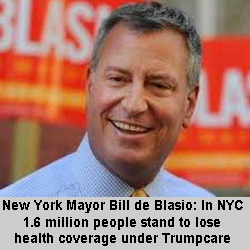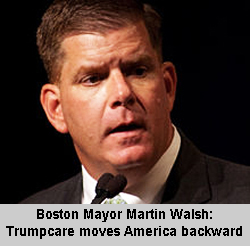FRONT PAGE
About us
 
ON OTHER US PAGES
US mayoral elections November 2019 MORE
US Mayors running for President MORE
US cities are waking up to the harm done by trauma in childhood and adult life MORE
In the US, cities lead in fighting poverty MORE
Corrupt US mayors MORE
Mass shootings in the USA MORE
US mayors to protect DREAMers MORE
America's undocumented immigrants pay billions in taxes MORE
In the US, cities lead in fighting poverty MORE
Spatial Planning and Development in the USA:
Economic growth is of paramount importance MORE
The ups and downs of Amazon’s
search for a second headquarter MORE
American public and mayors agree:
Keep Obamacare, forget Trumpcare MORE
More public involvement in law
enforcement needed to ease strain
between police and US communities MORE
American cities save money
by replacing obsolete urban
infrastructure with green spaces MORE
|
|
 American public and mayors agree: American public and mayors agree:
Keep Obamacare, forget Trumpcare
By Tony Favro
21 June 2017: It took seven years and 61 attempts, but, in May, the US House of Representatives managed to repeal the ‘Affordable Care Act’, commonly known as Obamacare, and replace it with the ‘American Health Care Act’ (call it Trumpcare). The fate of Trumpcare is now in the hands of the US Senate, which could pass the House's bill without changes, modify it, or ignore it. Until it is repealed by the Senate, Obamacare remains the law. Mayors of US cities have been outspoken in their condemnation of the House's repeated actions to repeal and replace Obamacare with Trumpcare.
In a letter to congressional leaders from the US Conference of Mayors, New York Mayor Bill de Blasio said: “In New York City, 1.6 million people stand to lose health coverage [under Trumpcare]. That’s mothers and children and grandparents who won’t be able to afford to see the doctor for the most basic forms of health care, and that is unacceptable.” Mayor Mitch Landrieu of New Orleans added, “America cannot be strong if its people are not healthy. You cannot replace something with nothing, or with something worse.” Trumpcare “moves America backward,” said Mayor Martin Walsh of Boston. Trumpcare “amounts to a death sentence for millions of Americans,“ according to Mayor Stephen Benjamin of Columbia, South Carolina. (1)
Strong concerns about the House’s action were also expressed by the health care industry, which represents of the some of the largest and fastest-growing employers in American cities. Almost all of the health care industry's major trade associations registered their dismay over the House's version of Trumpcare, including the American Medical Association, American Nurses Association, American Hospital Association, and the American Health Insurance Plans.
The general public is solidly behind the mayors and health care industry. An April Gallup poll showed that 55 percent of Americans approve of Obamacare. An April survey by the Kaiser Family Foundation found that 75 percent of Americans prefer to keep Obamacare, but improve it. (2)
 Obamacare versus Trumpcare Obamacare versus Trumpcare
Obamacare is based on four main pillars:
• An individual mandate, which means that everyone must have health insurance (either private insurance or federal Medicare insurance for the elderly or federal Medicaid insurance for the poor) or pay a tax penalty;
• Federal government subsidies for those who can't afford the cost of insurance;
• A minimum package of benefits each health insurance policy must cover, with no restrictions on pre-existing conditions;
• Reimbursements to doctors and other health care providers based on how well a person gets rather than the number of procedures the patient undergoes.
In practice, Obamacare's four strategies have meant that more people can afford to get preventative and chronic care, as well as primary care, which keeps them out of hospitals, especially emergency rooms. This has improved how health care is delivered in the United States as health care providers are incentivized to cooperate to provide patients, especially those with chronic ailments, with more holistic care. It also reduced the rate at which health care costs were increasing by about one-third. (3)
Trumpcare overturns much of this. For example, Trumpcare cuts subsidies for persons with pre-existing conditions. Trumpcare would allow commercial insurers to charge more for cancer, chronic obstructive pulmonary disease, Crohn's disease, cystic fibrosis, depression, diabetes, Down syndrome, eating disorders, epilepsy, glaucoma, gout, heart diseases, heartburn, high cholesterol, hypertension, kidney problems, mental health issues, sleep disorders, tuberculosis, tooth disease, and other ailments.
A provision in the Trumpcare bill also jeopardizes Obamacare’s cap on out-of-pocket expenses in employer-provided healthcare plans. The bottom line is that, under Trumpcare, sicker people will pay a lot more for their insurance, or, more likely, be unable to afford insurance. The Congressional Budget Office, which provides nonpartisan economic analysis for the US Congress, estimates that Trumpcare, as proposed, would cause 23 million people to lose health insurance coverage. Many hospitals and other health care providers will likely face credit downgrades if millions of Americans lose their insurance, leading to staffing cuts and job losses in the communities these institutions serve. (4)
 Background Background
According to the World Health Organization’s Global Health Expenditure Database, the United States spends more for health care - per capita and as a percent of GDP - than any other country, but has only the world’s 37th best health care system. By comparison, France is number 1 in the WHO database; Italy, 2; UK, 18; Germany, 25; Canada, 30. In other words, the effectiveness of the United States’ healthcare system is not particularly impressive despite its cost.
According to Cornell University economist Robert Frank and journalist Mark Hare, the US health care system has deep historical roots. During World War II, there were labor shortages in the US and caps on wages. Employers found it difficult to recruit workers, so they began offering fringe benefits like health care, which wasn’t taxed. In many cities, large medical facilities were established to deliver health care to workers and their families.
Very quickly, about sixty percent of the American population had employer-provided health insurance, a proportion that continues to this day. Many of these patients use their private insurance to receive health care through large regional providers like Kaiser Permanente, Cleveland Clinic, Mayo Clinic, and UR Medicine. Such providers employ their own doctors, nurses, and other professionals who collaborate on patients’ care and don’t get paid if they order more tests or procedures and thus have no incentive to run up patients’ bills.
These regional health care systems operate, in effect, like miniature versions of the UK’s National Health Services. Additionally, about a third of Americans are covered by Medicare and Medicaid, single-payer systems of socialized medicine operated by the federal government. Until Obamacare, about ten percent of the US population had no insurance, and about 50 million Americans had health insurance which didn’t cover preexisting conditions.
Millions of Americans had private policies, which covered little more than catastrophic illness or injuries, and only at a high cost. American hospitals and physicians are required to provide health care to the sickest and most vulnerable individuals, even if these individuals do not have adequate insurance or any insurance or the ability to pay for the medical services they receive. In other words, Obamacare was built on top of a complicated existing system, which combines market competition, socialized medicine, and public financial incentives to private health care providers. (5)
Generally, Americans like and support their complex health care system. The biggest criticism of Obamacare is that private insurers are exiting, leaving only one insurer in some markets. All major programs need periodic adjustments, but Republicans in Congress have steadfastly refused to support Obamacare or mend some of its shortcomings, going so far as to threaten to eliminate reimbursements to insurers for the cost of subsidies for those who cannot afford insurance.
Congress could easily stabilize insurance markets and regain the participation of insurers by continuing to subsidize the premiums and, perhaps, waiving the some of the deductibles and co-payments of those who qualify based on income. Congress could also authorize the government to negotiate the price of prescription drugs. On average, other countries pay 40 percent less for the same drugs that the United States, primarily because other countries’ national health care systems negotiate process down. If the American Congress lowered drug prices by 40 percent, health insurance premiums could drop an estimated eight percent. (6)
Single-payer solution?
There is a sense that Congressional Republicans, by advancing a plan that would cause millions of people to lose their health insurance and drive premiums higher for millions more, are attempting to go back in time when most voters prefer to move on.
“We can’t go backwards from the Affordable Care Act [Obamacare],” said Mayor Jon Abrams of Edgewood, New Mexico, adding that he would prefer a single-payer health care system, such as Medicare for all Americans.
The debate on federally-funded health care for everyone, known as universal or single-payer health care, is spreading in the United States. The political platforms of state Democratic parties in 16 states call for single-payer insurance, including Alaska, California, Hawaii, Maine, New York, North Dakota, Texas, and West Virginia.
How might a national single-payer health care system work?
According to Frank and Hare, one option is to financially strengthen Obamacare so that more insurers enter the system, and gradually decrease the age at which people can buy into the national Medicare program from the present 65 to 50. Another option is Medicare for all.
Medicare for all is likely the most expensive approach, requiring perhaps ten percent of GDP in additional taxes. However, recipients would pay much less in private medical-related payments and would probably receive better care. Evidence from around the world shows that countries with single-payer pay about half what the US pays to provide medical services and get better results.
A federally-funded single-payer system would mean less need for private policies, and big insurance companies can be expected to oppose any proposals for such a system. Gradually phasing in a single-payer system by, for example, having the eligibility age for Medicare go down step-by step. Most current Medicare recipients purchase supplemental insurance from private insurers, and this could continue. The federal government could also compensate private insurers for policy changes that drastically reduce their business.
In spite of Republican attempts to label Obamacare a jobs killer, economists Daan Struyven and Alec Phillips of Goldman Sachs estimate that Obamacare has directly created 500,000 new jobs since 2012. (7) A single-payer system—in essence a commitment to make all Americans healthier - would create hundreds of thousands, if not millions, of additional jobs in the health care industry. (8)
Republicans in the United States Senate are working on the House of Representatives’ Trumpcare bill, and reportedly will soon offer a version of their own. The Senate Republicans are working behind closed doors, a curious and risky approach given the importance of health care insurance to the majority of American voters.
In 2018, all of the members of the US House of Representatives and half of the US Senators will be up for election. Given the turbulence in Washington, it’s not possible to predict the political climate a year from now, but it’s not inconceivable that some form of federally-funded, universal, single-payer health care system will have the support of both major political parties—if the Republicans and President Trump do not succeed in a meaningful repeal of Obamacare.
“We have to put parties and politics aside,” says Mayor Juan Carlos Bermudez of Doral, Florida, “and find the best possible plan for universal health care.”
1) United States Conference of Mayors, January 25, 2017, The Nation’s Mayors Stress Impact of Affordable Care Act Repeal.
2) Gallup Poll, April 4, 2017, Affordable Care Act Gains Majority Approval for First Time; Kaiser Health Tracking Poll-Late April 2017: The Future of the ACA and Health Care & the Budget.
3) Centers for Medicare and Medicaid Services, National Health Expenditures Summary, CY 1960-2015.
4) George W. Chapman. GW Chapman Consulting blog posts: May and June 2017. Accessed 14 June 2017 at gwchapman-consulting.com.
5) Mark Hare and Robert Frank, The Real Health Care Fix, City Newspaper, Rochester, New York, 3-9 May 2017.
6) Hare and Frank; Chapman, op. cit
7) Elizabeth Schulze, Obamacare repeal could undermine a major pillar of President Trump's agenda, CNBC, 23 March 2017.
8) Hare and Frank, op cit.
|





 Obamacare versus Trumpcare
Obamacare versus Trumpcare Background
Background